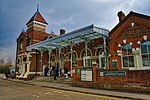St Andrew's Catholic School
St Andrews Catholic School is a Christian secondary school and sixth form college in Grange Road, Ottways Lane, Leatherhead, close to the town of Epsom, Surrey, England. Originally a convent back in the 19th century, St Andrews School was transformed into a school in 1901; it consists of three main buildings: the central building dating back to the 1900s, a sixth form and performance arts building, finished in 2008, and the Earl building which accommodates History, Geography and Languages, finished in 2017. Named in memory of John Earl who served as Chair of Governors.The school is on the boundary of Leatherhead and Ashtead and is primarily a faith school, and has links with the local diocese and churches.The school holds Specialist Maths and Computing College status and is one of the top 10 most popular schools in Surrey.Due to growing demand, St Andrews School has grown from 600 pupils in 2003 to 934 pupils in 2013 and to 1457 in 2020. The school is forecasted to continue to expand.
Excerpt from the Wikipedia article St Andrew's Catholic School (License: CC BY-SA 3.0, Authors).St Andrew's Catholic School
Grange Mount, Mole Valley Lower Ashtead
Geographical coordinates (GPS) Address Nearby Places Show on map
Geographical coordinates (GPS)
| Latitude | Longitude |
|---|---|
| N 51.3023 ° | E -0.3156 ° |
Address
St Andrew's School 6th Form
Grange Mount
KT22 7JT Mole Valley, Lower Ashtead
England, United Kingdom
Open on Google Maps








